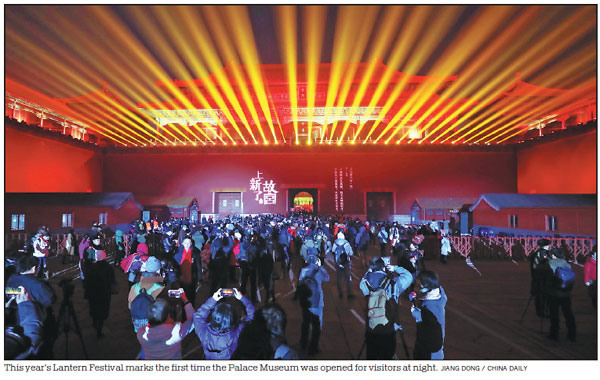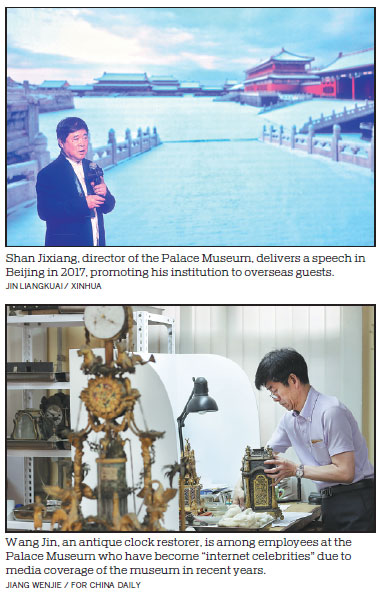Knight at the museum
Director faces both praise and criticism for rare Lantern Festival light shows, Wang Kaihao reports.
Two recent nights of dazzling light shows at the Palace Museum in Beijing has fetched the former imperial seat of government a lot of media attention.
Large crowds gathered in and around the compound, watching the display of colorful lights there on the night of Feb 19, which was celebrated as Lantern Festival in China.
It was the first time that the Palace Museum, also known as the Forbidden City, opened its gates to public visitors at night since the world's biggest palatial construction complex, which is about 720,000 square meters, became a museum in 1925. It was China's royal palace from 1420 to 1911.
But controversies also surfaced.
Scalpers charged even thousands of yuan for an entry ticket sensing the monumental opportunity to make money, though the reservation was officially "for free".
And, when some logos of sponsoring enterprises of the event were digitally projected on the Gate of Supreme Harmony at the museum in the light show, a wave of criticism followed.
Song Xiangguang, a museology professor at Peking University, asked on his social media account if the practice had violated basic principles of museum operation.
Shan Jixiang, 65, director of the museum, says according to the original plan, the lights would be projected on the Hall of Supreme Harmony, the highest-level architecture in the Forbidden City. But he knew that would look a little exaggerated to light up that highest-level architecture in the Forbidden City with flamboyant colors. He says he had less than 20 days to prepare for the light shows when he got the project. And he adds, in spite of his compromises and adjustments, he cannot please everyone.
As the chief custodian of over 1.86 million cultural relics, many of which are royal collections from over centuries, Shan knows any major decision he makes will come under public scrutiny.
"I'm walking on thin ice," he says.
"But there are things I need to do. If all these treasures sleep in warehouses and people cannot feel a connection with them, as museum administrators we won't be doing enough."
When he sat in the director's chair in 2012, Shan had his work cut out: Over some years before, the museum was hit by burglary, a visitor broke its exhibits and only 30 percent of the complex area was accessible to the public that led to overcrowding in peak season. A common remark by visitors back then suggested they didn't want to see the architecture alone but also the relics.
Shan, who was an architect and an urban planning official before the museum job, chose a methodology different from his predecessors. He traveled across the country to deliver speeches promoting the museum to the public, officials, entrepreneurs and scholars.
He entered every locked room in the complex. Many were full of cultural relics that had gathered dust. Shan got his team to organize the inventory in categories, and put more artifacts on display. An ongoing renovation in the compound, once completed, will enable the opening of a large exhibition space.
About 80 percent of the complex area has been unlocked for the public.
Most of its 3.4 kilometer outer city wall is now accessible, which also provided the major visiting route for the night tours during this year's Lantern Festival.
While more than half of the museum's annual expenditure is covered by fiscal allocation, the rest is through raising funds, as Shan said at a recent forum.
For the renovation of the Hall of Mental Cultivation, the residence of the last eight Qing Dynasty(1644-1911) emperors, Shan persuaded Hui Wing Mau, a real estate tycoon and philanthropist in Hong Kong, to donate 80 million yuan($12 million). Hui's company also spent more than 100 million yuan to buy a precious Ming Dynasty(1368-1644) painting and donated it to the museum.
The Palace Museum has worked with Hui to develop Forbidden City-themed fine art galleries in some of the company's real estate projects.
Many other entrepreneurs have offered financially support to the museum.
In 2018, 17.5 million visits were recorded at the Palace Museum. It remains the most visited museum in the world. And thanks to an ongoing exhibition on royal rituals during Lunar New Year, visits to the complex increased by 70 percent during this year's Spring Festival in February, compared with the same period last year.
"No matter how many visitors we receive," he says, "only a small portion of our country's big population can come here. We want the Palace Museum to 'go home' to more people".
Cooperating with major Chinese companies such as Tencent and 163.com, the Palace Museum licenses digital game designers to draw inspiration from its collections. Some employees of the museum became "internet celebrities", thanks to TV shows like Masters in the Forbidden City and The Nation's Biggest Treasures, which went viral.
The museum has also made efforts to develop its cultural souvenirs since 2013.
Cooperating with numerous designers, cultural elements in the museum's collections were turned into myriad daily-use articles. More than 10,000 kinds of souvenirs have been developed.
The sales of souvenirs surpassed 1.5 billion yuan in 2017.
In November, the museum took the initiative to produce its first TV reality show inviting designers into the palace to develop products based on cultural relics hidden in lesser-known corners of the complex.
But in December, when some cosmetics released by the museum's online stores as cultural products triggered discussion online, the museum halted the sale to "further improve quality".
Following the Lantern Festival nights, Shan faced more questions.
In an interview with Xinhua News Agency last week, an official in charge of museum development with the National Cultural Heritage Administration who remains anonymous, implied concerns without naming any specific museum.
Bottom lines of museums should be such so as to put social benefits first, the official told the news agency.
"A trend of overwhelming entertainment and commercialization should be avoided," the official added.
Nevertheless, museum staff do not "economically benefit" from the rocketing revenue of the museum, which can only be used to develop more projects, not to award the employees, according to current rules.
Wang Jin is a restorer of antique clocks who has worked at the museum for over 40 years. He is one of the employees to become famous, thanks to Masters of the Forbidden City.
"Many visitors recognize me and want to take pictures with me," Wang says. "It's a good thing that our job is attracting more attention, but my job doesn't change much. It still needs focus, patience and persistence."
These might be common mottos for staff at the Palace Museum, including Shan. When Shan set a 80,000-people limit on the daily visitor number in 2015 to contain overcrowding, and closed physical ticket offices and made the ticket sale online two years later, to improve efficiency, others had expressed doubts. But he insisted on the steps, and now some other tourism sites also follow such practice.
As the country's top museum, the Palace Museum has influenced the industry.
Statistics from the Ministry of Culture and Tourism also show that 40 percent of tourists during Spring Festival visited museums this year.
"I don't know whether I will still be the director when the 600th anniversary of the Forbidden City is celebrated in 2020," Shan says.
"But I will be really thankful if all the ongoing work is finished by then."
Contact the writer at wangkaihao@chinadaily.com.cn


(China Daily 03/03/2019 page8)














